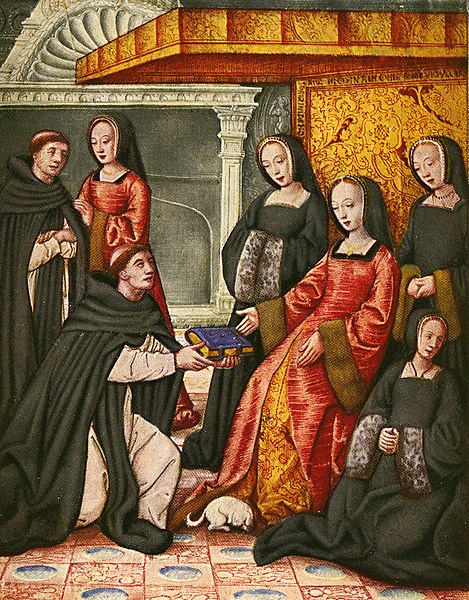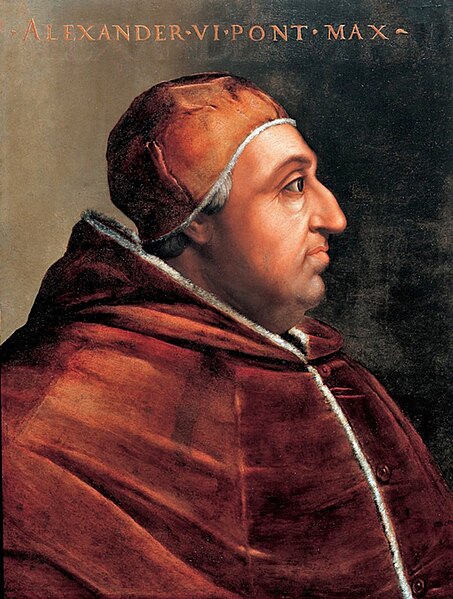 |
| Anne of Brittany |
Preparation for an Invasion
Before
setting off on his Italian jaunt Charles secured his northern borders. In May
1493 Margaret of Austria was allowed to return to her father’s court, in return
the Treaty of Senlis gave the Duchy of Burgundy to France. Artois and Franche-Comté were returned to Maximilian. The Governor of the Low Countries, Philip the Fair, paid homage to Charles for Flanders.
Anne had spent
much of her first pregnancy resting, but when she became pregnant for the
second time in late 1492/early 1493 Anne travelled around the country with Charles.
She went into labour during a drive in the forest of Courcelles. Francis was born prematurely and
stillborn; he was buried at Notre-Dame de Cléry in Cléry St André. Anne gave birth to a stillborn
daughter in March 1494; during this, her third pregnancy, Anne avoided travel.
Instead she resided at the chateau d’Amboise near the Dauphin.
 |
| Henry VII |
With an eye
to the future, Charles disbanded his army in Brittany; this was more to save
money than anything else. The wars in Brittany had drained his resources and so
when in October 1492 Henry VII landed at Calais and laid siege to Boulogne, Charles was reliant on the charity of the major towns to
pay for the army to repel the invaders[i]. The Peace of Étaples was signed on 3rd
November whereby France agreed to pay England 750,000 gold écus[ii] at the rate of 25,000
écus per annum.
In March
1494 Charles moved his court to Lyons, in part to prepare for the upcoming
invasion of Italy. With him went Louis d’Orléans, one of his boon companions in
pleasure and sport. Octavien St-Gelais[iii] commented;
‘Monseigneur d’Orléans
always accompanied him [Charles] because when he was not about, the court was
greatly diminished…..Monseigneur d’Orléans was the first to try everything.’[iv]
A Jaunt Abroad
 |
| Alexander VI |
Charles’ invasion of Italy in search of glory in the Kingdom of Naples aimed to dethrone Alfonso II son of Ferdinand I. Charles was a direct descendent of Charles of Anjou who conquered Sicily and Naples in the 13th
century. Alfonso’s father was the bastard son of Alfonso V of Aragon who had seized the Neapolitan throne in June 1442. Pope
Alexander VI had married his son Joffre to Ferdinand’s granddaughter Sancia of Aragon and the arrival of the French in Italy wanting to
overturn Alexander’s complex manoeuvrings was not welcome.
Upon the
arrival of the French in Italy Alexander’s bitter rival Cardinal Julius della Rovere immediately left Rome
to join up with Charles who was accompanied by Louis d’Orléans. Della Rovere
was not the only one who greeted the invaders; Ercole I d’Esté, Duke of Ferrara met with Charles and Duke Ludovico Sforza welcomed Charles to Milan.
 |
| Piero d' Medici |
On 31st
December 1494 Rome opened her gates to Charles, who had already removed Piero de’ Medici from his power base in Florence. On 15th January Charles
and Alexander came to an agreement; Charles agreed to perform a public ceremony
of obedience to the pope who promised to raise two French bishops to the rank
of cardinal and he appointed his son Cesare as papal legate to the invaders.
‘Charles VIII spotted the
pope and, while Alexander VI was still some twelve feet away, made two
genuflections which the pope pretended not to see. Then, just as the king was
about to genuflect for a third time, Alexander removed his biretta and motioned
him to stop and then kissed him.’[v]
King of Naples
 |
| Painting believed to be Cesare Borgia |
Within three
months Charles was in Naples, accompanied by Cesare Borgia, a
hostage for his father’s continuing support. Alfonso immediately abdicated and
entered a monastery and his son Ferdinand fled. On May 12th 1495
Charles was crowned King of Naples.
The Italians
were becoming uneasy, concerned about Charles’ vaulting ambitions. Ferdinand
and Isabella, in conjunction with Maximilian, had their own designs for Naples.
Ludovico Sforza, worried by Louis d’Orléans claims on Milan[vi], joined Alexander’s Holy League[vii].
Charles was
incandescent but the reality of his situation meant he and his army were soon
retreating up through Italy with the spoils of the campaign. The Neapolitans
had been taken aback by the viciousness of Charles’ entourage. And his failure
to fulfil the promises he made on his arrival, to reform the church, bring
justice and liberty to the Italian people and lead a crusade against the Turks,
turned Italians against him. Philippe
de Commines, the chronicler, said of the ultimately abortive expedition;
‘If we do but consider how
often this army was inclined to disband since its first arrival at Vienne in Dauphiné….it
must of necessity be acknowledged that God Almighty conducted the enterprise.’[viii]
 |
| Battle of Fornovo |
On 5th
July 1495 the French met with the combined armies of the League at the Battle of Fornovo. The League’s 30,000 men were commanded by Francesco II Gonzaga, Marquess of Mantua. Charles lost his baggage train but managed to march on to reach Asti that evening.
On 7th
July Ferdinand was back in Naples with the city under his control. Two weeks
later Charles was back in France, leaving a French presence in Italy under the
command of Louis d’Orléans. By French law Charles was not able to undertake a
rescue mission as Charles Orlando died and the king could not leave France
until the succession was assured.
For the
French people the mercenaries and soldiers fighting for the king brought home
the unwanted gift of the pox or Italian disease[ix]. The disease had spread
throughout France by the end of 1497; Rouen, Niort, Bordeaux and Poitiers were particularly hard hit.
Desperation At Home
 |
| Moulins |
While Charles was away in
Italy Anne spent her time in Lyon or at Moulins with her
sister-in-law Anne de Beaujeu. Anne acted as her husband’s regent, throughout
the 15 months of Charles’ absence, although she was only eighteen. Anne was
devoted to the cult of the Franciscan François de Paule[x], introducing an aura of
mysticism to the court. She wrote to Charles every day. She also found time to
order a tomb for her
father from Michel Colombe,
a Breton sculptor. Anne’s face was used as a model for Prudence on the tomb.
In February 1494 Anne
accompanied the king to Lyon, where he was preparing to depart for Italy. After
arriving on 15 March, she attended all of the ceremonies and the stress of the
occasion caused her to go into premature labour and the child was stillborn.
Anne had another stillborn child, a daughter, in March 1495 after getting
pregnant again in late 1494.
 |
| Tours Cathedral |
On 6th December
1495, while his father and mother were in Lyons, Charles Orlando died of the
measles epidemic sweeping Touraine.
Anne was desolated; so much so that her sanity and her life were feared for.
Charles Orlando was buried at the Cathedral of Saint-Martin, Tours. He was described by
Commines as a;
‘Beautiful child and daring in word, not
fearing the things that the other children are accustomed to fear.’[xi]
Charles spent the spring of
1496 trying to organise two expeditions; one to relieve Gilbert de Bourbon Montpensier who was besieged in Atella and the other to defend Asti from the attacks of
Ludovico Sforza. He was hindered by a shortage of money; Charles had wasted all
the money that his father had amassed over the years.
On 8th September
1496 Anne gave birth to Charles, Dauphin of France. Charles died on 2nd
October 1496. His death prompted Anne to withdraw temporarily to Moulins in
despair. He was buried at Tours Cathedral so that his mother would be able to
visit to pray at his tomb which was to be ornamented by Jean
Juste, a sculptor of Italian origin who
moved to Tours.
Francis, Dauphin of France
was born in July 1497 and died several hours after his birth. He was buried at
with his siblings at Tours Cathedral. Anne of France was born on 20th
March 1498 dying the same day; she too was buried at Tours Cathedral.
Bibliography
Louis XII –
Frederic J Baumgartner, MacMillan Press Ltd 1996
Renaissance
Europe – JR Hale, Wm Collins Sons and Co Ltd 1971
The Borgias
– Mary Hollingsworth, Quercus Editions Ltd 2014
The Rise and
Fall of Renaissance France – RJ Knecht, Fontana Press 1996
Absolute
Monarchs – John Julius Norwich, Random House 2011
A History of
France 1460-1560 – David Potter, MacMillan Press Ltd 1995
Anne of
Brittany – Helen Josephine Sanborn, General Books 2012
The March of
Folly – Barbara W Tuchman, Sphere Books Ltd 1984
Twice
Crowned Queen – Constance de la Warr, Eveliegh Nash 1905 (Reprint 2015)
[ii]
In 2013
the relative: historic standard of living
value of that income or wealth is £496,500,000.00 economic status value of that income or wealth is £13,560,000,000.00 economic power value of that income or wealth is £195,100,000,000.00 www.measuringworth.com
[iv]
Louis XII - Baumgartner
[v]
The Borgias - Hollingsworth
[vi]
Through his grandmother Valentina Visconti
[vii]
Cesare managed to slip away
[viii]
Renaissance Europe - Hale
[ix]
Syphilis
[x]
As was her daughter Claude
No comments:
Post a Comment
Note: only a member of this blog may post a comment.